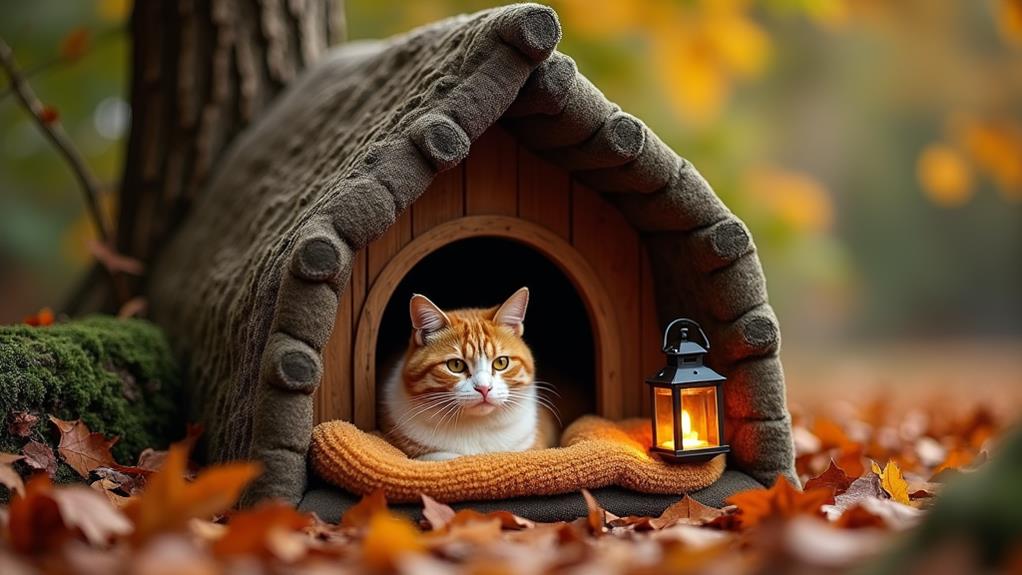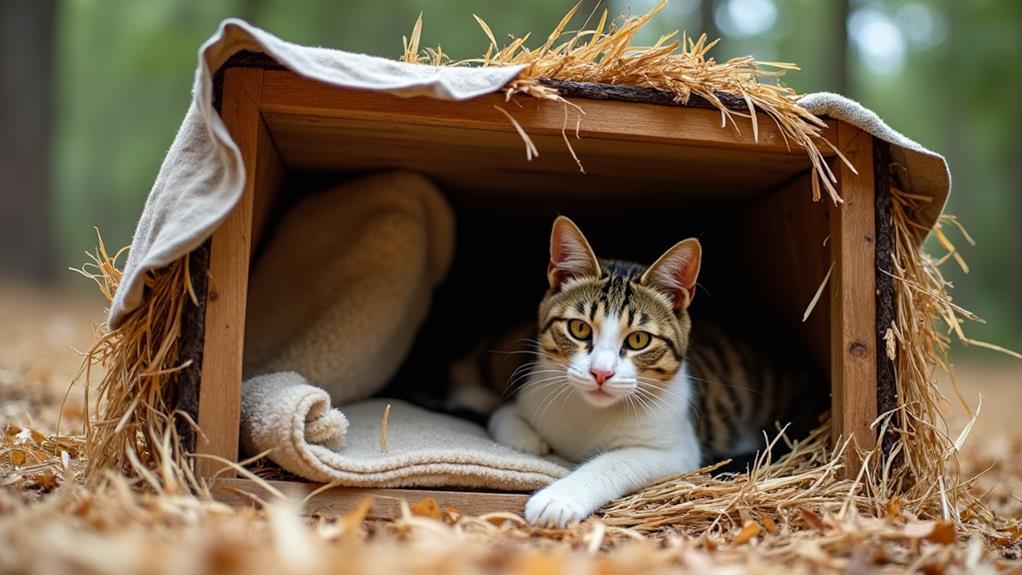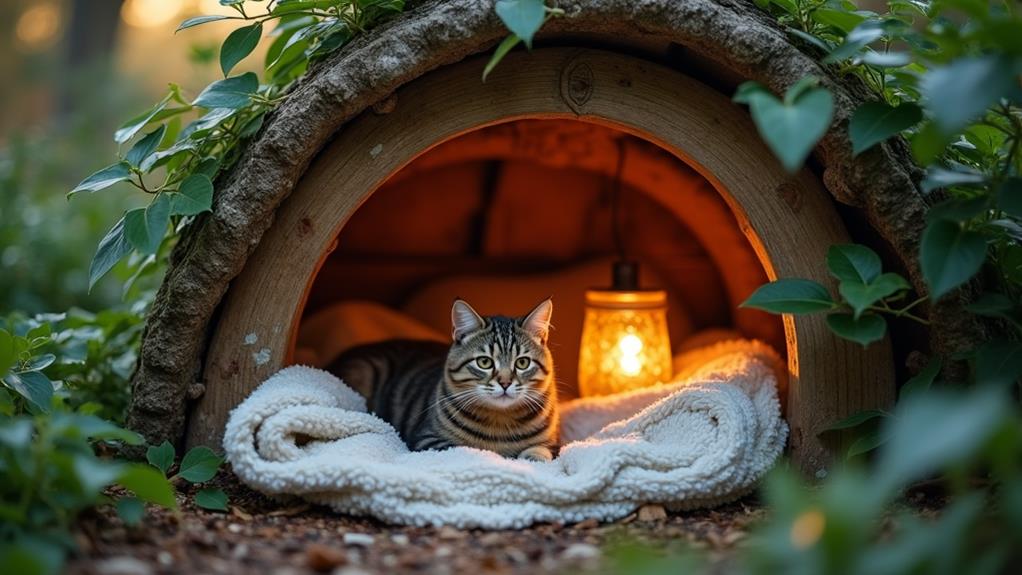How to Get a Feral Cat to Sleep in a Cat House: Creating a Cozy Shelter

To encourage a feral cat to sleep in a cat house, start by positioning the shelter in a secure, quiet location like a garage or covered porch. Raise it off the ground to keep away moisture and cold. Verify the opening is small to keep larger predators out and add an extra exit for escapability. Use durable materials and insulate with straw to keep it cozy. Place food and water nearby to entice them. Make the shelter appealing with familiar scents or catnip. By establishing this inviting and safe haven, you create a cozy spot that can become their preferred refuge. Want to uncover more tips and tricks?
Enticing Feral Cats With Food
By strategically using food, you can effectively entice feral cats to investigate and eventually settle in a cat house. Establish a regular feeding schedule near the outdoor cat shelter. This routine not only encourages feral cats to visit but helps them become familiar with the shelter's location. Place food and water close to the cat house to reduce travel distance, especially crucial during inclement weather. This setup is more inviting and guarantees the cats can stay dry and safe from the rain.
Utilize tools like the K&H Thermo-Kitty Café to keep food warm, making it more appealing during colder months. The cozy warmth of the food can be an irresistible draw for feral cats seeking both nourishment and comfort. Furthermore, the K&H Thermal-Bowl is a great way to guarantee water doesn't freeze, even in temperatures as low as -20°F, keeping hydration accessible to the cats.
Positioning food and water near the shelter can also attract skittish cats, helping them feel more comfortable. As they get used to the consistent presence of food and water, they'll begin associating the nearby shelter with safety and security, eventually making it their home.
Choosing a Safe Shelter Location
After enticing feral cats with food, selecting the right location for their shelter is crucial to guarantee their safety and comfort. Position the shelter in a secure area like a barn, garage, or covered porch. These locations offer protection against stray dogs and harsh weather. Ensuring the shelter is raised off the ground will protect it from cold and moisture, providing a dry and warm environment for the cats.
Pay attention to the shelter's entrance size. Keep it small, around 5.5 to 6 inches, to deter larger predators while still allowing easy access for the cats. This design feature will make the feral cats feel safe and more inclined to use the shelter. Additionally, integrate two exits into the shelter layout. Having multiple escape routes is crucial for cats to feel secure, offering them a quick way to flee if danger arises.
Place the shelter out of sight from frequent human activity and potential threats. This encourages feral cats to investigate and feel at ease using the space. By creating a secure area that meets these criteria, you'll greatly increase the chances of the feral cats making the shelter their new home.
Harnessing Warmth for Attraction

Feral cats naturally seek warmth, making your shelter more attractive by ensuring it's cozy and inviting. To create a welcoming cat shelter, focus on utilizing warmth effectively. Insulating materials, such as straw or shredded newspaper, are excellent choices for lining the inside. These materials trap heat, keeping the interior warm and inviting, especially during chilly nights.
Consider the size of your cat shelter, too. Smaller shelters do a better job of retaining heat, particularly when several feral cats snuggle up together. This communal warmth is a natural draw for them, offering both comfort and security. For an added touch of warmth, you might investigate heated options like the K&H Thermo Outdoor Kitty House or the K&H Extreme Weather Heated Kitty Pad. These products are designed to improve heat retention, making your shelter much more appealing.
Selecting Durable Outdoor Shelters
When choosing an outdoor shelter for feral cats, it's vital to focus on durability and protection. As you search for the perfect cat houses, consider options made from sturdy materials like durable plastic or weather-resistant wood. These materials guarantee the shelters withstand harsh outdoor conditions, providing long-lasting protection for your outdoor cat and community cats.
Insulated shelters are important, especially during colder months. Models like the K&H Thermo Outdoor Kitty House come with both heated and unheated options, guaranteeing the cats stay warm when temperatures drop. Also, raise the shelters off the ground. This prevents cold exposure and protects from flooding due to rain or snow, while also keeping predators at bay.
Pay attention to the design of the shelters. Small entrances, about 5.5 to 6 inches, are ideal. They allow easy access for cats while keeping larger animals out, improving the safety and security of the cats inside. If you're caring for multiple community cats, consider multi-kitty shelters like the K&H Thermo Outdoor Multi-Kitty A-Frame. These options accommodate several cats comfortably and maintain warmth through their insulated design, providing a cozy retreat for all.
Essential Shelter Building Materials

Constructing a snug and weather-resistant refuge for feral cats necessitates a few essential materials to guarantee warmth and safety. Start with a large plastic tub, about 30 gallons, which forms the main structure of your cat shelter. This durable material withstands harsh weather conditions, providing reliable protection. Inside, place a smaller 20-gallon plastic tub to create an insulated inner sanctuary. This double-layer setup improves warmth and comfort, vital for the cats' well-being during colder months.
Insulation is key, and straw is your best option. Unlike blankets or hay, straw effectively retains heat and resists moisture, ensuring the shelter stays dry. It also provides a soft, comfortable bedding for the cats. You'll need a box cutter to carve out entrances in the tubs. Make sure these openings are just big enough for cats to pass through, keeping predators at bay.
For added protection against the elements, repurpose a plastic flowerpot to create a tube entrance. This will help minimize wind and rain from entering the shelter. Remember to keep replacement straw and materials on hand for regular maintenance, ensuring the shelter remains inviting and dry throughout winter.
Steps to Construct a Cozy Shelter
To begin constructing a cozy shelter for feral cats, start by selecting a large 30-gallon plastic tub as your main structure. This tub will serve as the outer shell of your shelter, providing a weather-resistant home for outdoor cats. Inside this, you'll use a smaller 20-gallon tub for insulation. Here's how to build the shelter:
- Cut an Entrance: Make a 6x6 inch entrance on the larger tub, positioned above ground level. This size lets cats enter easily but keeps larger predators out.
- Layer Insulation: Place the smaller tub inside the larger one, leaving space between them. Fill this gap with straw, which retains heat effectively and offers a comfortable bedding option for the cats.
- Add Drainage: Drill drainage holes in the lid of the larger tub. These holes will prevent water accumulation, guaranteeing the shelter stays dry even during wet weather.
- Seal and Position: Use strong tape to seal the tubs together securely. Position the shelter near food and water sources but away from wind and potential dangers, increasing the likelihood that cats will use it.
These steps will guarantee your feral cat shelter remains a warm, inviting refuge.
Encouraging Shelter Usage

Now that you've built a cozy shelter for feral cats, it's time to make it appealing so they choose it as a safe haven. Position the shelter near food and water sources. This proximity will keep the feral cats coming back regularly, making it easier for them to find and start using the shelter. Make sure the shelter is in a protected area, like a garage or covered porch, to provide a secure environment away from potential threats.
To entice the cats further, consider using enticing scents or familiar items inside the shelter. This could include catnip or a piece of fabric with their scent. These enhancements will encourage exploration and make the space feel more inviting and comforting.
Allow the cats to acclimate gradually. Keep the shelter accessible so they can investigate at their own pace without feeling pressured. If you're accommodating a larger group, combine multiple smaller shelters instead of a single large structure. This setup not only accommodates more cats but also improves their sense of security. By following these steps, you'll encourage feral cats to use the shelter you've thoughtfully prepared for them.




